Just because you are living in the aftermath of a major disaster or even a society toppling event doesn’t mean that the daily processes of life won’t go on more or less as normal.
For instance, you’ll still need to eat, and if you are enduring the circumstances at home, either because you decided to bug in or because the event did not directly affect your home, that means the kitchen will still be the nerve center of your house.
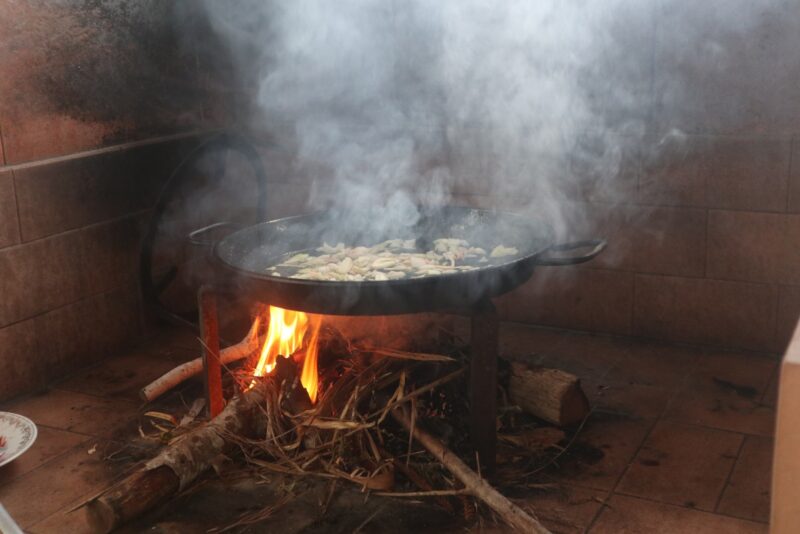
Unfortunately, just because you’re home is still standing doesn’t mean your kitchen will be functioning normally. One watchword during any major disaster worth the name is power outage.
Whether or not you’re stove is electric or gas that is probably going to put the kibosh on most of your usual cooking plans. To say this will make meal prep an order of magnitude more difficult is an understatement.
It follows, then, that preppers must have plans in place for cooking indoors during emergency situations when they’re usual means of heating or preparing food are offline.
Don’t worry; we have your back today with indoor options for cooking that will serve you well during any emergency. With just a little bit of prior preparation you’ll soon be whipping up proper meals like usual!
Loss of Power or Gas Means Your Usual Stove is Out of Action
Both natural and man-made disasters have a way of knocking out power in the immediate area, and major disasters can seriously hamper or even totally knock out utilities in a region.
Electricity is almost invariably the first to go, and if you have an electric stove top and oven they’ll be out of action for the duration if you don’t have your own backup power supply.
You can also kiss your microwave goodbye along with your toaster oven and any other electrical appliances.
But don’t be feeling too smug just because you have a gas cooktop. Gas supplies might be safe, more or less, for most disasters but damage or degradation to the intricate supply lines that deliver it is far from out of the question, and many municipalities will shut down gas supply immediately out of an abundance of caution.
You’ll be in the same boat as your electric oven brethren in that case.
The bottom line is, you won’t be able to count on cooking unless you have your own, self-contained methods for doing so. Chances are, you already do, in the form of an outdoor fire pit or a backyard grill, be it charcoal or propane.
However, cooking indoors is far more challenging, logistically. You’ll have significant safety and operational hazards to deal with if you want to handle it without harming yourself or others or potentially burning your house down.
This is not a time to figure something out in the heat of the moment!
Alternate Cooking Methods Can be Dangerous!
Anytime you have a source of intense heat inside your home, to say nothing of open flame, there is the risk of accident and injury. You need to look no further than house fires statistics on an annual basis for confirmation of this.
Most house fires begin in the kitchen as a result of normal cooking activity, so you can imagine how much worse it will be when suddenly you are improvising and perhaps not even cooking in the kitchen at all, ostensibly the location in your home best equipped for dealing with it.
It must be stressed that using any of the alternate cooking methods on this list entails a certain amount of risk on your part, and you must be completely engaged with the process to prevent disaster.
Furthermore, you’ll have more to worry about than the risk of accidental fire.
The combustion of any material releases deadly carbon monoxide gas into the atmosphere, and if that gas is allowed to build up due to a lack of proper ventilation it could make you and your family extremely sick, or worse.
Check out the list of hazards below for more information.
Fire
The most obvious and most devastating consequence of a mishap with indoor cooking is an accidental fire. A small, out of control fire can rapidly turn into a devastating conflagration that can consume your home and everything in it in a matter of minutes.
To say this would add insult to injury during an SHTF scenario is an understatement. A house fire is a disaster all its own anytime, and to be rendered homeless and deprived of all of your accumulated preps is a devastating loss under the circumstances.
For this reason you must take excruciating care that you protect all flammable surfaces and materials from your emergency cooking solution.
Remember that something does not have to come into direct contact with a hot surface to be heated to the point of combustion, and then anything, from a spatter of hot grease to a burning ember could jump out or off of the cooking surface to ignite something some distance away.
As always, you must have properly rated and functioning fire extinguishers on hand for dealing with such an eventuality if you want to have any hope of stopping it before it gets out of control.
Make sure you keep them handy and close, and now as before rehearse a family fire response plan.
Carbon Monoxide
Carbon monoxide is another major threat when doing any kind of indoor cooking, or burning anything indoors for that matter. CO gas is deadly, and it is also odorless, invisible and tasteless.
Symptoms will be noticeable as it builds up in your bloodstream, however, and begins with comparatively mild feelings of discomfort that will progress to confusion along with flu-like symptoms before victims eventually slip into a coma from which they will not wake if they are still in the contaminated area.
Many victims of carbon monoxide poisoning fall victim to it while they sleep, such is its deadly and insidious effect.
Understand that anything you burn, any fuel you ignite, no matter how clean any fishing it is will release carbon monoxide gas, though some fuels are much, much worse than others in this regard.
This is the reason why you are constantly warned to never, ever drag your outdoor grill inside for emergency usage during storm season and throughout the winter.
Accordingly, any of the emergency options on the list below must be used in an area with adequate ventilation, and you must use the strictest caution to prevent CO gas from building up in enclosed areas.
If possible, all of your carbon monoxide detectors in your home should be battery powered or self-contained as a backup precaution.
Burn Hazard
You don’t need me to tell you that any surface hot enough to cook on is hot enough to severely burn you.
But unlike your electric stove top or gas range, a couple of options on this list feature flames that burn so hot and so cleanly they are invisible, or very nearly so.
One option doesn’t use any electricity or fuel at all, but can still get hot enough to badly burn you with a careless touch, so be careful!
With all of these precautions out of the way, let us get on to our list.
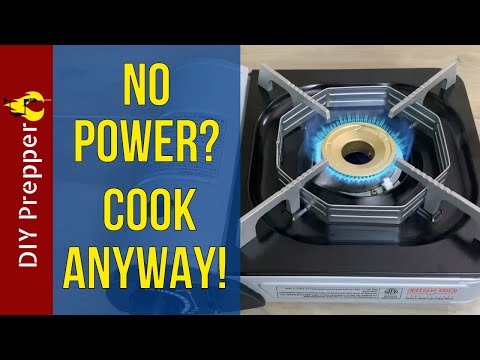
10 Emergency Indoor Cooking Options
Electric Burner
The first entry on our list might seem a little discordant since we are talking about emergency options for indoor cooking, and I just spent a whole section telling you all about how your electric range and stove are going to be out of action for our purposes. That’s still true, but hear me out.
If you have any capability of generating your own electricity, for instance using a standby or portable generator or perhaps pre-charged, deep cycle whole house battery banks on your property, you might be better served simply hooking up a small electric burner for your cooking needs.
Compared to your large and power hungry stove and cooktop, a single electric burner should plug into a typical outlet and will consume far less electricity. This will make the most of your now precious supply and also streamline setup.
You’ll probably need to restrict yourself to boiling water, making soup and other one pot meals compared to your typical four burner arrangement, but it is more than enough to take care of the basics under the circumstances and one of the few options on this list that does not generate carbon monoxide in operation.
Fireplace
One of the best and simplest options for emergency indoor cooking is your fireplace, if you have one. In bygone eras the fireplace was the primary method of cooking, period!
However, to make the most of your fireplace for cooking you’ll need some specialized gear to help you place vessels over or near the flames safely and under control.
Pot holders, racks, grates, stands and the like are essential, as are long-handled utensils for interacting with your food without crowding the firebox.
This method works best if you have a wood burning fireplace, but you should be surprised how well you can do with a gas fireplace assuming it is still functional.
As always, have a plan for dealing with accidental fires, and cooking over open flames inside your home is risky business, especially if anything is spilled and ignited on the flames.
Note, just because you have an operational fireplace does not mean you are free from worry about carbon monoxide buildup. Make sure your chimney is regularly inspected and serviced so that it will perform without problem when you need it.
Wood-burning Stove
Coming up right behind a fireplace when it comes to convenient and comparatively safe indoor cooking is the wood burning stove.
Still the primary source of heat in many places around the world and because of affection or necessity the same thing in remote homesteads here in the U.S., wood burning stoves are quaint and charming but also highly efficient and practical if they are properly maintained and installed.
Modern examples in particular burn extremely hot and highly efficient, minimizing smoke and maximizing return on your fuel.
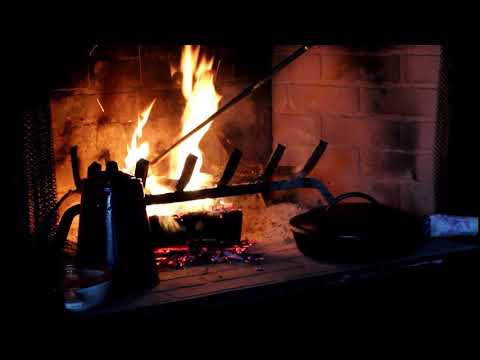
There are two ways to cook on a wood burning stove. If you are fortunate enough to have a wood burning stove with an actual cooktop, all you’ll need to do is stoke it and get to work whipping up a meal.
If you don’t have a dedicated cooktop on your wood burning stove, you might need to set down a cast iron griddle or some other improvised surface on top of it for the purpose.
Naturally, your wood burning stove is no good without wood and the best burning performance comes from seasoned firewood.
Putting in greenwood or unseasoned wood will work in a pinch but is going to generate considerably more smoke and that will result in dramatic build up of creosote in your exhaust flue.
As always, you must keep your wood burning stove and ventilation system inspected and maintained if you want to depend on it in an emergency!
Camp Stove
The camp stove you use when out on the trail or at the campsite can be repurposed for cooking indoors with a little bit of caution.
Camp stoves definitely have the efficiency and portability on their side to get the job done in an emergency situation, but they have some decided drawbacks you’ll need to be aware of.
First, you’ll be limited to heating pots or similar vessels, as a rule. You won’t be doing any baking with one of these bad boys.
Second, you’ll only be able to heat one pot at a time, perhaps two with the largest and old fashioned briefcase style models as popularized by Coleman.
Another thing to keep in mind, these stoves are typically intended to be set directly on the ground and that means the source of the heat will be very close to your flooring or countertop. You must take care to protect against burns and accidental fires because of this!
Lastly, whatever kind of fuel your camp stove uses, be it propane, white gas or something else, it will definitely emit carbon monoxide, same as usual.
Ensure that you have proper ventilation and plenty of fresh air, and considering how furiously many of these little stoves go through fuel you could be generating carbon monoxide at an accelerated rate.
Tealight Oven
Tealight ovens are an ingenious option for indoor cooking. Consisting of a lightweight, metal enclosure with a door that looks for all the world like a miniature version of the oven in your kitchen, tea light ovens work exactly as you are probably surmising.
For heat, tea light ovens except a bank of tea light candles, typically in a removable insert for easy replacement, that allows you surprisingly precise control over temperature with a little practice.
In conjunction with its high efficiency middle enclosure tea light ovens can get screaming hot, hot enough to bake bread and take care of any other tasks that you would use your oven for. Best of all, they are relatively easy to use and quite safe, with minimal risks of accidental fire or carbon monoxide build up because of their mode of operation.
Naturally, you’ll need to have plenty of tea lights on hand to feed these hungry little stoves over time, but this is likely a small concern. Tea lights are plentiful and dirt cheap, and so long as you are stocking up now you should have more than enough to get you through a bad situation.
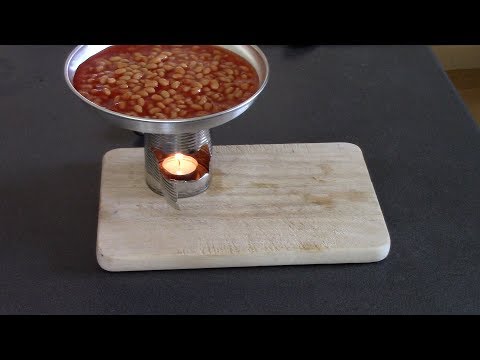
Candles
Piggybacking off the concept of the tea light stove, it is possible to meaningfully warm up your food, and even do some simplistic cooking, using candles alone.
A group of candles clustered closely together can easily produce enough heat to boil a small quantity of water, heat soup, canned vegetables and other similar foods.
The trick is positioning them in such a way that you can safely place your cookware over the flames without knocking them over or snuffing them out. If your candles are short this is considerably easier, but if they are tall, elegant tapering candles you’re going to have a tougher time.
One easy solution is to place your candles on a pan or inside some other holder and then place them in the bottom of your oven before repositioning a rack to hold your cookware close to the flames. Make sure you leave the door cracked so they can get plenty of oxygen or they will go out!
like tea lights, this is one of the safer options when it comes to the release of carbon monoxide since their output will be absolutely minimal, even when you are burning multiples at once, but candles remain a significant contributor to the number of house fires yearly, so always keep an eye on them and place them somewhere that pets or children cannot reach them.
Flameless Heaters
Flameless heaters are chemical compounds, typically containing various metals, that will heat up vigorously when exposed to moisture. This exothermic reaction is quite impressive and is easily capable of meaningfully heating up a small quantity of food.
Probably the most famous example of this type of emergency heater is found in the common MRE. Simply add a little bit of water to the pouch, insert your ration pack and then give it a couple of minutes to heat up your dinner.
Thankfully, you don’t have to rely strictly on MREs or MRE sized portions to make use of this technology.
There are a variety of products on the market capable of heating up much larger portions inside larger compartments, and all you need to do is add a little bit of water which you should, I trust, have on hand.
This is a great option for people who don’t have too many mouths to feed because they produce no meaningful amount of carbon monoxide except perhaps trace levels, they require no additional fuel source and considering most of them utilize a wet reaction the risk of fire is vanishingly rare, they’ll never zero, so be careful.
One thing you must be cautious of with these heaters in particular is the fact that they generate a considerable amount of hot steam in operation, so they must be handled and opened with the greatest care after use unless you want to get burned.

Alcohol Stove
Alcohol stoves have long been choice of mariners and anyone else who needs a reliable, super clean and super hot stove in a compact footprint.
Using denatured alcohol as a fuel, or other alcohol blends, these stoves are easy to operate, adaptable and more than capable of cranking out an amazing amount of heat. They can easily heat food in a pot or pan, fry eggs, boil water and more.
Even better, these stoves run so hot and so efficiently the release of carbon monoxide is minimized though, again, the output is not meaningless and they should always be used in an area with adequate ventilation.
That being said, compared to other, smokier stoves with dirtier fuels these are a godsend.
What’s more, the alcohol used to fuel these stoves has an extraordinarily long shelf life compared to kerosene or other similar products, making them ideal for long haul prepping with a minimum of logistical fuss.
However, if alcohol stoves have a drawback it is that the flames produced can barely be seen, if at all. If you don’t know the stove is on or anyone else does not understand the danger posed by an alcohol stove it is easy to get burned or start an accidental fire.
Similarly, you must make sure you extinguish one of these stoves cautiously and ensure that it is completely out before walking away from it!
Canned Heat
So called canned heat, in reality disposable alcohol burners, go by a variety of brand names but they all work similarly.
In essence, they are a one shot, disposable alcohol stove as described above, and were originally designed to heat food over a steam tray for catering and other food service tasks were more elaborate setups were impossible or impractical.
For the money, canned heat is an excellent short-term option for indoor cooking and is available in a variety of configurations and types.
Burning anywhere from 2 to 6 hours, perhaps a little more, one or two of these puppies can easily heat up a pot of food in short order or keep it warm for a long time.
Prospective buyers should note that certain varieties of canned heat are intended specifically for indoor food service or buffet use, and produce basically no carbon monoxide, while others are intended for indoor outdoor use and produce a little bit of carbon monoxide. regardless and as always, the user must ensure adequate ventilation for safety.
Also note that like alcohol stoves above, the flame produced by canned heat is often completely invisible so take great care when operating them!
Solar Oven
And probably what is the most jaw-dropping entry on this list. I know it sounds crazy, but you can use a solar oven for indoor cooking. before you start dropping moms on us down in the comments, let me explain.
For those who are unfamiliar, a solar oven is exactly what it sounds like, an oven that uses solar energy to cook your food.
Typically consisting of a highly reflective metal box that is sealed with a closing glass lid, solar ovens rely on the copious radiation emitted by our nearest star to gently and evenly but thoroughly cook food from all sides.
These really are marvelous devices and though they have limitations they are one of the best, and one of my favorite, post disaster cooking tools.
Obviously you’ll need sunlight and plenty of it for a solar oven to operate, but so long as that light reaches into your house your solar oven can work just the same as it would outside.
If your windows or skylights are kept clean they proved to be very little, if any impediment to sunlight and if you position your solar oven to catch these rays and protect the surface beneath it it will cook just as well indoors as out.
Obviously a solar oven is not going to work on cloudy days or at night, but assuming your house is set up with plenty of windows or skylights and you keep them clean a solar oven can handle everything from baking bread to roasting whole chickens!
Even better, there are absolutely zero carbon monoxide emissions from this gadget.
Conclusion
You don’t need to relegate yourself to cooking outdoors over an open fire in the aftermath of a major disaster that sees your kitchen knocked offline. With just a little bit of prior planning and the right equipment you can keep preparing meals more or less as normal indoors.
The list above will provide you with options to serve any purpose in any circumstances, so make sure you review it carefully and keep your survival food prep plan on track.
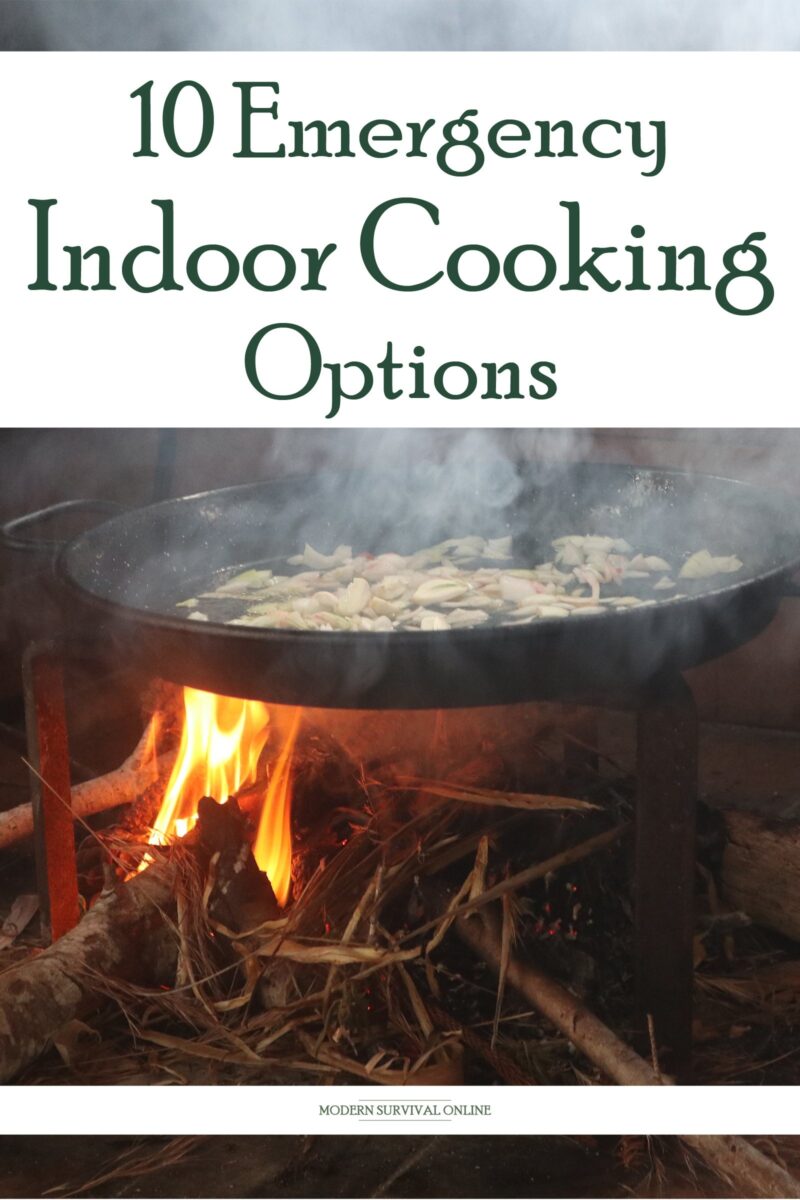
via Modern Survival Online https://ift.tt/3sd48Bo
No comments:
Post a Comment